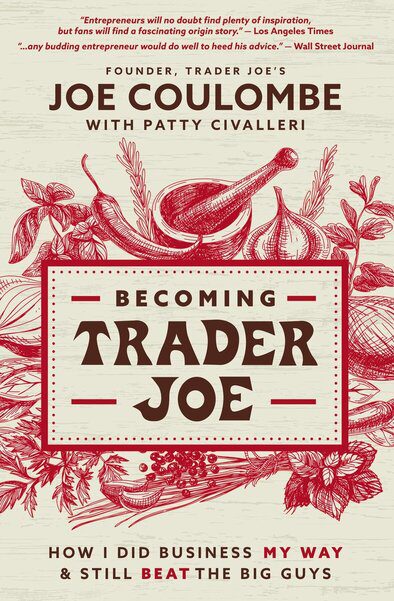In Becoming Trader Joe: How I Did Business My Way and Still Beat the Big Guys, the founder of Trader Joe, Joe Coulombe, shares the founding story of building the grocery store chain, lessons learned in the process and insights for navigating the entrepreneurial journey. He started the company in 1958, and as of 2020, the company generated revenue of US$16.5 billion and employed 50,000+ people.
As a partner of Rexall, Joe had started Pronto in 1958 as a copy of 7-Eleven, because there were no 7-Elevens in California.
Trader Joe’s was conceived from those two demographic news stories. What I saw here was a small but growing demographic opportunity in people who were well-educated. 7-Eleven, and the whole convenience store genre, served the most basic needs of the most mindless demographics with cigarettes, Coca-Cola, milk, Budweiser, candy, bread, eggs. Dimly, I saw an opportunity to differentiate ourselves radically from mainstream retailing to mainstream people.
The Wages of Success
“I wrote this book to help entrepreneurs and would-be entrepreneurs. That’s why there’s a lack of miracles and a surplus of marketing details including buying, advertising, distributing, and running stores; and lots of discussion of “the wages of success”—how we built a successful business on high wages.”
The convenience store business is 90 percent real estate, 10 percent all other (merchandising, personnel, etc.). In real estate, it’s the tenant’s balance sheet that counts.
Pronto Markets
“In a 1958 partnership with Rexall Drug Co., we started Pronto Markets. After growing it to six stores, I bought out Rexall’s shares in 1962. Then, in 1967, when I had reached eighteen Pronto locations, I began the transition of Pronto into Trader Joe’s. I resigned at the end of 1988. During those twenty-six years, our sales grew at a compound rate of 19 percent per year.” As a partner of Rexall, I had started Pronto in 1958 as a copy of 7-Eleven, because there were no 7-Elevens in California.”
“Trying to find an optimum solution in business is a waste of time: the factors in the equation are changing all the time.”
The decline of the stock market accelerated. I walked into the office of the treasurer of Rexall one day in May 1962. He was on the phone with the Wall Street Journal, trying to explain why Rexall’s stock had just gone from 60 to 21. I put a note on his desk: “I will buy Pronto Markets for book value.” He cupped his hand over the phone and muttered, “Ten thousand dollars over book and you’ve got it.” I shook his hand. I needed to raise the money within ninety days.
It is better to be vaguely right than exactly wrong.—Carveth Read
The Two Insights that started Traders Joe
The clue, the keystone of the arch of Trader Joe’s, was a small news item in Scientific American in 1965. When we left Stanford, my father-in-law, Bill Steere, a professor of botany, gave me a subscription to Scientific American. In terms of creating my fortune, it’s the most important magazine I’ve ever read.”
“The news item said that, of all the people in the United States who were qualified to go to college in 1932, in the pit of the Depression, only 2 percent actually did. By contrast, in 1964, of all the people qualified to go to college, 60 percent in fact actually did. The big change, of course, was the GI Bill of Rights that went into effect in 1945. It was the greatest experiment in mass higher education ever attempted by any society in any era. By 1965, we were into the second generation of veterans going to college (and the pace stepped up later, because of Vietnam).
“A second news item, one from the Wall Street Journal, told me that the Boeing 747 would go into service in 1970, and that it would slash the cost of international travel. (It did: the real cost of going to Europe today is about one-fifteenth of what it was in 1950.) In Pronto Markets, we had noticed that people who travelled—even to San Francisco—were far more adventurous in what they were willing to put in their stomachs. Travel is, after all, a form of education.”
“Anticipating Peter Drucker’s advice by almost thirty years, Trader Joe’s was conceived from those two demographic news stories. What I saw here was a small but growing demographic opportunity in people who were well-educated. 7-Eleven, and the whole convenience store genre, served the most basic needs of the most mindless demographics with cigarettes, Coca-Cola, milk, Budweiser, candy, bread, eggs. Dimly, I saw an opportunity to differentiate ourselves radically from mainstream retailing to mainstream people.”
“As we evolved Trader Joe’s, its greatest departure from the norm wasn’t its size or its decor. It was our commitment to product knowledge, something which was totally foreign to the mass-merchant culture, and our turning our backs to branded merchandise.”
Naming Traders Joe
So Trader Joe’s was conceived in an atmosphere of fun-leisure-party-prosperity. A couple of years earlier, we had done the Jungle Cruise at Disneyland, which stuck in my head. “Yellow Bird” and “Beyond the Reef” were being played in the hotel lobbies. Trader Vic’s was at its peak.
The thirty-somethings (including us) of that day were drinking not Chardonnay but Mai Tais and Fog Cutters (you know, those drinks that come with little umbrellas) to protect the booze from the “Rain on the Roof” feature of those Polynesian bars. And somewhere in the dim recesses of childhood I must have seen Red Dust with Jean Harlow and Clark Gable, and read White Shadows in the South Seas and something about Trader Horn.
Pay your People Well
This is the most important single business decision I ever made: to pay people well. First Pronto Markets and then Trader Joe’s had the highest-paid, highest-benefited people in retailing. Time and again I am asked why no one has successfully replicated Trader Joe’s. The answer is that no one has been willing to pay the wages and benefits, and thereby attract—and keep—the quality of people who work at Trader Joe’s. My standard was simple: the average full-time employee in the stores would make the median family income for California.
“Early in my career I learned there are two kinds of decisions: the ones that are easily reversible and the ones that aren’t”
Listening to your people
“Equally important was our practice of giving every full-time employee an interview every six months. At Stanford, I’d been taught that employees never organize because of money: they organize because of un-listened-to grievances. We set up a program under which each employee (including some part-timers) was interviewed, not by the immediate superior, the store manager, but by the manager’s superior. The principal purpose of this program was to vent grievances and address them where possible. And I think this program was as important as pay in keeping employees with us.”
At Stanford, I’d been taught that employees never organize because of money: they organize because of un-listened-to grievances.
Transparency Lesson from General Patton
That’s why, throughout my career, my policy has been full disclosure to employees about the true state of our affairs, almost to the point of imprudence. I took a cue from General Patton, who thought that the greatest danger was not that the enemy would learn his plans, but that his own troops would not.
No Secrets Policy
“People like secrets, because secrets bring power. Consider the priests of ancient Greece who kept the secret of pi. This is one reason I never had a secretary. When I found “executive secretaries” in the various companies I took over after leaving Trader Joe’s, I got rid of them. They hold too many secrets and are actively interested in augmenting their inventory. There’s a place for secrets, and it’s usually in the office of the head of Human Resources. But it should not be in the chain of command, where the CEO’s secretary too often gets inserted by force of circumstance if not by force of personality.”
All the Best in your quest to get better. Don’t Settle: Live with Passion.



Comments are closed.